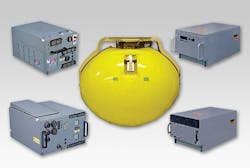Raytheon wins $152.9 million contract to provide 53 airborne radar systems for P-8A Poseidon
Officials of the Naval Air Systems Command at Patuxent River Naval Air Station, Md., announced a $152.9 million contract last week to the Raytheon Space and Airborne Systems segment in McKinney, Texas, to provide AN/APY-10 radar systems for U.S. and Australian P-8A aircraft.
The radar systems are for lots 2 through 6 of the P-8A full-rate production aircraft. There are about 16 P-8A aircraft in one production lot. Raytheon will provide 46 radars for the U.S. Navy and seven for the government of Australia.
The P-8A is a specially hardened and reinforced version of the Boeing 737-800 passenger jet, and is designed to operate either at extremely low altitudes or at high altitudes over the ocean to search for potentially hostile submarines. The P-8A is designed to withstand the rigors of low-altitude turbulence and exposure to salt spray.
The Poseidon is replacing the P-3 Orion for long-range maritime patrol and anti-submarine warfare. The aircraft is equipped with anti-ship missiles, sophisticated torpedoes, sonobuoys, radar, and signals-intelligence gear. The Navy plans to buy 117 P-8As to replace its P-3 fleet.
The Raytheon AN/APY-10 maritime, littoral and overland surveillance radar is a new design for the P-8A. Compared with the previous-generation AN/APS-137 radar, the AN/APY-10 has reduced size, weight and power (SWaP); additional target track capability, a new color weather avoidance mode, and room for technology growth, Raytheon officials say.
The AN/APY-10 is integrated into the Boeing mission control and display system aboard the Poseidon for control, display and data distribution. The radar also will provide ultra-high-resolution imaging modes for maritime and overland operations.
The radar fits in the nose of the Poseidon. On this contract Raytheon will do the work in McKinney, Texas; Chelmsford, Mass.; Little Falls, N.J.; San Carlos, Calif.; Black Mountain, N.C.; Ontario, Canada; Ashburn, Va.; Poway, Calif.; Simsbury, Conn.; Sunnyvale, Calif.; Philadelphia; Boston; and other locations, and should be finished by August 2021.
For more information contact Raytheon Space and Airborne Systems online at www.raytheon.com, or Naval Air Systems Command at www.navair.navy.mil.

